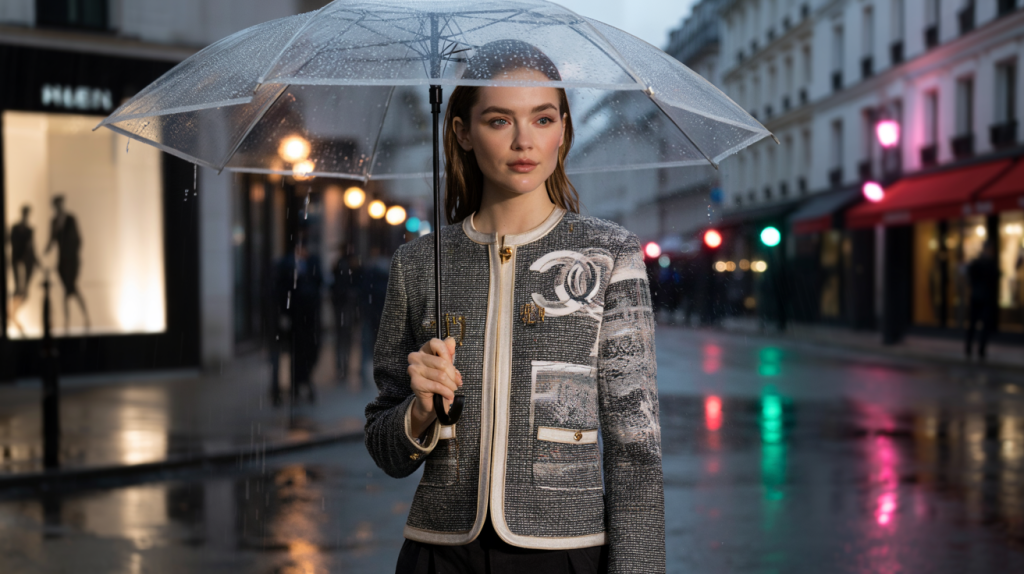A jacket that shifts when raindrops hit – that alone explains why queries for a Chanel rain-reactive piece are spiking. The idea blends couture fantasy with city-weather pragmatism, promising a hidden motif or color play that only reveals outdoors.
Context matters. As of late 2024, Chanel has not issued a public retail announcement naming a rain-reactive jacket, and yet interest keeps rising. So the real questions are simple: what does rain-reactive mean in apparel, how would a Chanel version likely perform, and what signals hint at timing and price tier.
Chanel rain-reactive jacket : the buzz and the facts
The premise is fashion-forward but not sci-fi. Rain-reactive garments use water-activated inks or finishes that reveal a pattern when wet, then fade back as the fabric dries. It suits modern outerwear and plays well with Chanel’s visual language – think tweed textures, graphic grids, or discreet double C codes that stay quiet until the first drizzle.
There is no product page to point to yet, so expectations lean on Chanel’s track record with materials and the high bar set by its runway storytelling. Scarcity, capsule drops, tight boutique allocation – that model tends to apply when the house tests a novel textile. The interest is there. The risk is fakes rushing in before any official launch.
How rain-reactive fabrics work in fashion
Most rain-reactive effects rely on hydrochromic chemistry, a finish or ink that turns transparent or shifts tone when exposed to water. Designers print it over a base artwork, so rainfall acts like a reveal switch. As drying happens, the surface returns to its original state.
Three common routes show up in technical fashion:
- Hydrochromic screen prints – a water-activated layer hides a logo or pattern until it gets wet.
- Microencapsulated dyes – tiny capsules in a coating trigger a color change upon moisture contact.
- Yarn-level finishes – filaments receive a hydrophilic treatment so sections darken in rain, creating subtle contrast.
Performance still matters. Waterproof shells are often rated by hydrostatic head under ISO 811 testing, with many urban jackets in the 10,000 mm range and storm-ready pieces at 20,000 to 28,000 mm. A luxury version could blend a breathable membrane with a rain-reactive exterior print, so the effect appears without sacrificing comfort.
Chanel numbers and timeline : shows, investments, sustainability
Chanel’s runway cadence signals the feasibility. The Cruise 2024/25 show staged in Marseille on 2 May 2024 leaned into movement and light, and the Métiers d’Art program keeps pushing fabric storytelling season after season. A rain-reactive surface would fit that narrative arc without looking gimmicky.
The brand also has the scale to industrialize a niche textile. Chanel reported 2023 revenue of about 19.7 billion dollars, up 16 percent year on year, in results published in May 2024. That level of growth funds experiments that smaller labels can hardly roadmap, especially when new chemistry, testing, and quality assurance are involved.
On the responsibility side, Chanel’s “Mission 1.5” outlined climate targets in 2020, including cutting absolute emissions from operations by 50 percent by 2030 versus a 2018 base year, and reaching 100 percent renewable electricity by 2025. Any water-reactive finish would be expected to align with those public commitments – low-VOC inks, restricted substances compliance, and durability across care cycles.
Care, availability, and how to avoid regrets
Care is the catch. Hydrochromic finishes dislike aggressive heat or harsh detergents. Warm – not hot – washes, gentle liquid detergent, and air dry protect the effect. Steamers over irons. And spot-cleaning beats full cycles when only a cuff needs attention. Treat it like a print, because it is.
Availability, if Chanel proceeds, would likely start as a tight capsule through boutiques and select retailers. Check product sheets for exact language such as “water-activated print” or “hydrochromic overlay”. Ask for the waterproof rating in mm and the breathability metric in g/m²/24h to compare with the performance jacket already in your closet. That data exists in testing files even for fashion houses.
Authenticity checks help while buzz runs ahead of launches. Chanel distribution is controlled, serials and materials are consistent, and inks should reveal crisply under a light mist – not smear when dry. If a listing cannot provide a clear wet-and-dry photo pair, pause. Sounds basic, yet it definetly filters out trouble.
What is still missing is a formal product announcement with specs and pricing. Until that lands, interested shoppers can track runway notes, watch boutique previews, and focus on the technical phrasing that signals the real thing – hydrochromic, ISO 811 figures, and care instructions that mention temperature limits. When those details line up, the rain is about to show the jacket’s secret.
